



Coccidiosis and Necrotic Enteritis in Layer Pullets: a Syrian Experience with Orego-Stim
Case report from Syria demonstrating the use of Orego-Stim to control coccidiosis and necrotic enteritis in layer pullets from Meriden Animal Health in Technical Bulletin 13.Introduction
The first 16 weeks of a pullet’s life are critical to its commercial potential in egg production. Astute management during this period can assure that the pullets reach the laying house ready to deliver their bred-in performance potential. Mistakes made during the first 16 weeks generally cannot be corrected in the laying period4. Therefore it is vital to keep the growing pullets healthy and free from disease.
A flock of layers can only perform up to its genetic potential when disease influence is minimised. The appearance of diseases such as coccidiosis can vary from a subclinical effect on performance to outright severe mortality4. Coccidiosis is a disease of utmost economic importance to a layer farm and the main challenge is to identify and control the disease.
Most layer farmers in Syria use anticoccidial drugs to control coccidiosis, and they usually choose to use a combination of amprolium and clopidol in feed. Coccidial vaccines have very limited use in Syria.
History of the Outbreak
The coccidiosis outbreak occurred in a flock of Hy-Line layer pullets of 5,500 birds, aged 110 days during the rearing period. This particular farm generally had a history of coccidiosis challenge in all previous flocks during the pullet stage of the rearing period, between 11 and 14 weeks of age. The birds were usually infected with Eimeria necatrix and E. maxima but in this case, the coccidiosis outbreak was complicated by a mixed necrotic enteritis infection.
Necrotic enteritis is an equally important enterotoxaemic intestinal disease of poultry caused by the Gram-positive bacterium, Clostridium perfringens. It is usually known to accompany major coccidiosis outbreaks and can cause a sudden increase in mortality. In this particular case, the farmers did not use any in-feed coccidiostats or antibiotic growth promoters, as they thought such control measures would not be required in hot weather, since the rearing period was in summer.
Clinical Signs and Post Mortem Findings
 |
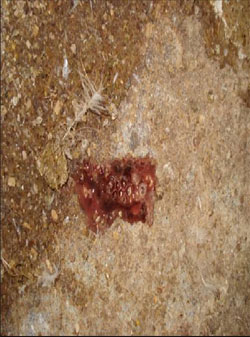 |
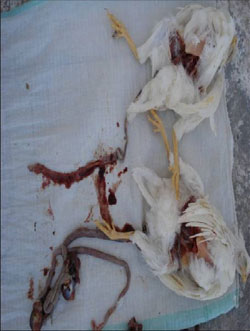 |
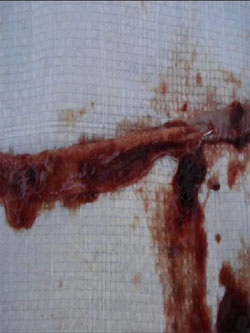 |
 |
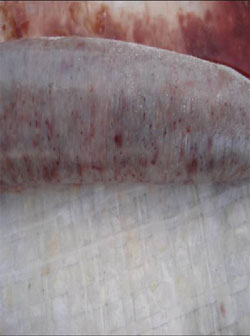 |
Orego-Stim® as a Treatment for Coccidiosis and Necrotic Enteritis
Orego-Stim has been proven to contain anticoccidial properties3. It has long been used for prevention and control of coccidiosis and necrotic enteritis in poultry production worldwide. Besides its phenolic mode of action against pathogenic bacteria such as Clostridium perfringens, it also has a different mechanism against intracellular protozoan parasites such as Eimeria spp.
In the normal intestinal mucosa, the epithelial lining is regularly shed and replacement occurs by cell division from within the crypts5. Phenols act on the gut lining by increasing the rate of enterocyte turnover by about twice the normal rate2,7,8,9. Coccidial infections occur when poultry ingest sporulated oocysts from the environment. This is followed by a period of asexual development (schizogony) and then a sexual phase (gametogony), wherein the parasites multiply within the enterocytes1.
The phenolic compounds in Orego-Stim disrupt the lifecycle of coccidian parasites by speeding up the rate of shedding of the gut lining. Through this mode of action, intracellular coccidial sporozoites are shed before they have the opportunity to penetrate deeper into the gut wall. Coccidiosis is therefore prevented or controlled by creating an environment that is hostile to the completion of the parasite lifecycle6. This mode of action is similar to that of ionophore coccidiostats such as salinomycin and monensin, that have been used as coccidiostats worldwide.
In this case, Orego-Stim Liquid was applied at treatment dosages of 500ml per 1,000 litres of drinking water for five days upon detection of a sudden increase in mortality as follows:
| Date | Mortality | Notes |
|---|---|---|
| 1-10-2006 | 3 | |
| 2-10-2006 | 5 | |
| 3-10-2006 | 46 | Orego-Stim treatment was started at 500ml per 1,000 litres of drinking water upon onset of clinical signs & high mortality |
| 4-10-2006 | 39 | |
| 5-10-2006 | 22 | |
| 6-10-2006 | 7 | |
| 7-10-2006 | 7 | |
| 8-10-2006 | 8 |
Orego-Stim to Treat Coccidiosis and Necrotic Enteritis
The diarrhoea and blood-stained droppings returned to their dry and normal texture and consistency. The intestines showed pink and healthy mucosal epithelia and there was no longer any evidence of petechial haemorrhage or necrotic tissue within the intestines.
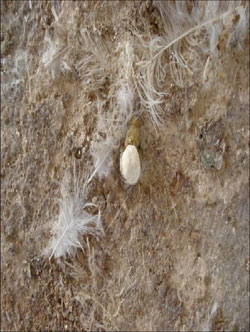 |
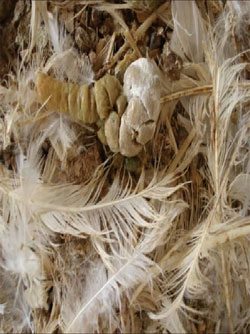 |
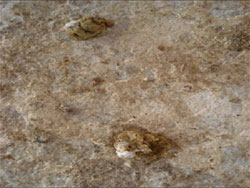 |
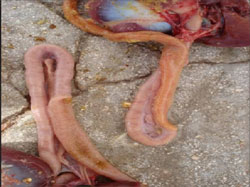 |
 |
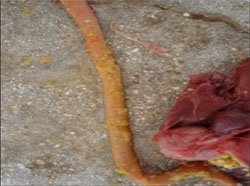 |

Conclusion
Coccidiosis is a disease that spares no poultry farm and in the context of commercial layers, it usually affects pullets during the growing stage, even if they are raised in cages. Coccidiosis occurs frequently in farms where coccidiostats are not used or are overused (due to the development of resistance towards the coccidiostat) and also where husbandry practice is not strict. The situation worsens when coccidiosis outbreaks are complicated by a mixed, concurrent necrotic enteritis infection.
Due to its mode of action on bacteria such as Clostridium perfringens and its ability to inhibit the lifecycle of coccidiosis, the use of Orego-Stim has proven to be a natural, safe, economical and practical solution to the treatment of both coccidiosis and necrotic enteritis in poultry production. Its efficacy in limiting these concurrent diseases is recognised globally, especially in countries where the use of antibiotic growth promoters and coccidiostats are banned by legislation.
Profile of veterinarian in charge of Orego-Stim treatment experience in Syria
Dr Haysam Demeriah (DVM) graduated from the Faculty of Veterinary Science, Al-Baath University in Hama, Syria in 1991 and started off his career as a Farm Supervisor at Dr Riad Kussaibati Broiler Farm. From May 1993 to December 1994, he was assigned as the Supervisor of Veterinary Pharmacy for the Productive Project Administration at the Syrian Ministry of Defence. In January 1995, he joined Khatib Poultry and has since held various positions within the company, including Head of Khatib Hatchery, Technical Supervisor of Hubbard ISA Grandparent Stock and After Sales Technical Supervisor for Customer Flocks in the Technical Service Department. He is now Technical Sales Advisor for Hubbard Parent Stock Breeders and Intervet poultry vaccines. Dr Haysam remains a strong believer in the efficacy of Orego-Stim in controlling various disease problems of poultry, which include coccidiosis, necrotic enteritis and candidiasis.
Further Reading
| - | Find out more information on the diseases mentioned in this article by clicking here. |
August 2011








